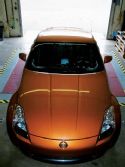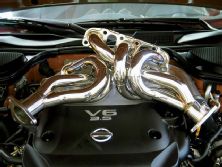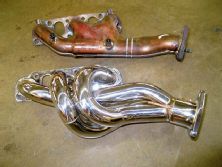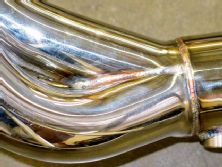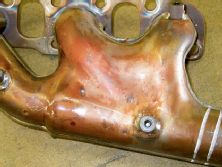Ever get stuck in bumper-to-bumper traffic on the highway? As a Southern California native, stop-and-go traffic is an everyday affair, once on the way to work and once on the way home. There's not much to do when stuck in traffic. Maybe check out the surroundings. One of the ways I pass time is checking out other motorist's license plate frames. Some of the best ones I've seen: "When I grow up, I want to be just like Barbie. That b!+@# has everything." And "Get in, sit down, hold on and shut up." The latter of the two, I can truly relate to; I'm often surrounded by motorists whose lack of driving skills force me to perform some pretty spirited maneuvering. One car that deserves such a license plate frame on every single car leaving the dealership floor is the Nissan 350Z. The 350Z is a car you can't drive slowly; in fact, doing so indicates a serious mental im-balance. The Z beckons you to smash the throttle and carve through traffic. On an off-ramp, it begs to be pushed around the corner as you modulate the brake for maximum traction on the front wheels. A red light only angers it, once the light turns green, leaving two black strips on the asphalt is a necessity. There's nothing more you can ask for, right? Here at Turbo magazine, there's always something more and most often that is to make the car a little faster.
The crew at DC Sports agreed with us and developed trick tubular headers for the 350Z. DC Sports offers two models of headers for the 350Z; one comes ceramic coated ($632.75) and the other in stainless steel ($906.25). We opted to go with the stainless-steel version since it would be a crime not to be able to show off this high-quality piece under the hood of the Nissan. Compared to the factory exhaust manifold, the three runners merge almost immediately after exiting the exhaust port. It looks like there's a lot of restrictions in the factory manifold design. Take a good look at the DC Sports headers and you can easily tell the runners are nearly equal length and the collector is a true three-into-one merge piece for better flow. Mandrel-bent stainless-steel tubing (1-5/8-inch) is used throughout and the flanges are CNC-machined from stainless-steel. Even the 02 bung is made from stainless steel.
As anyone who has performed the task can tell you, installing headers on a 350Z is a real pain in the behind. It took four hours to remove the factory headers and install the DC Sports units. As with all stainless-steel products, make sure you wipe down the header with brake cleaner before starting up the car (unless you like blue fingerprint stains all over your new header). It looks like a thousand bucks, but does it perform like it? Our tester was a pristine track model 350Z with 4,000 miles on the clock and came in this edition of Dyno Cell--already equipped with an AEM cold-air intake, Invidia exhaust, Sun Systems Hyper Ground and Unorthodox Racing Pulleys. On SP Engineering's Dynojet chassis dyno, the Nissan registered 247.7 hp and 233.3 lb-ft of torque as delivered. With the DC Sports headers in place, the 350Z generated 248.8 hp and 239.2 lb-ft of torque. The real gains were generated in the mid-range where the VQ35DE needs it most, with a gain of 9.1 hp and 12.5 lb-ft of torque.
On the road there was a noticeable improvement from 3500 to 5000 rpm where the Nissan would really scream. We did, however, notice a bit more under-hood heat because of the missing heat shield, but the increase was not dramatic. If you can get over the four-hour install, the DC Sports headers are a definite must for all you 350Z enthusiasts out there. The headers deliver the power in the mid-section so if you shift crisply you should be able to slice through traffic with much less drama.

